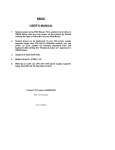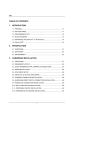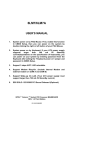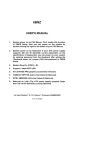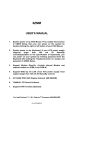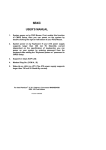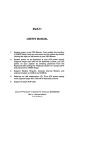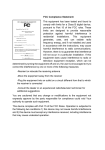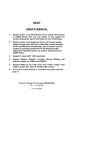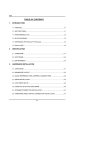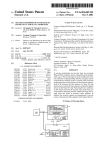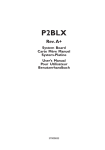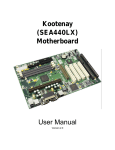Download 6lmm7 user`s manual
Transcript
6LMM7 USER'S MANUAL 1. System power on by PS/2 Mouse: First, enable this function in CMOS Setup, then you can power on the system by double clicking the right or left button of your PS/2 Mouse. 2. System power on by Keyboard: If your ATX power supply supports larger than 300 mA 5V Stand-By current (dependent on the specification of keyboards), you can power on your system by entering password from the Keyboard after setting the “Keyboard power on” jumper (JP1) and password in CMOS Setup. 3. Support 3 steps ACPI LED selectable. 4. Support Modem Ring-On. (Include internal Modem and external modem on COM A and COM B) 5. Support Wake-up On LAN. (Your ATX power supply must support larger than 720 mA 5V Stand-By current) 6. ATI RAGE PRO AGP Display Onboard. 7. YAMAHA PCI Sound Onboard. Intel Celeron TM Processor MAINBOARD REV. 1.0 Second Edition R-10-02-090114 6LMM7 The author assumes no responsibility for any errors or omissions that may appear in this document nor does it make a commitment to update the information contained herein. Third-party brands and names are the property of their respective owners. January 14, 1999 Taipei, Taiwan 1 Quick Installation Guide I. Quick Installation Guide : CPU SPEED SETUP The default system bus speed is 66 MHz. The user can change the DIP SWITCH (SW) selection to set up the CPU speed for 366 - 433MHz processor. M The CPU speed must match with the frequency RATIO. It will cause system hanging up if the frequency RATIO is higher than that of CPU. DIP SWITCH (SW) FREQ. RATIO EXT.CLK. MHz INT.CLK. MHz 1 2 3 4 OFF ON OFF ON 4.5 66 300 ON OFF OFF ON 5 66 333 OFF OFF OFF ON 5.5 66 366 ON ON ON OFF 6 66 400 OFF ON ON OFF 6.5 66 433 MJP2, JP3, JP4 (Select the system speed¡ Ð 66, 75, 83 MHz ) MAIN CLOCK JP4 JP3 JP2 66MHz 2-3 2-3 2-3 75MHz 2-3 1-2 2-3 83MHz 1-2 2-3 1-2 «Note: We don’t recommend you to setup your system speed to 75 or 83MHz because these frequencies are not the standard specifications for CPU, Chipset and most of the peripherals. Whether your system can run under 75 or 83MHz properly will depend on your hardware configurations: CPU, SDRAM, Cards, etc. 2 6LMM7 TM 6LMM7 1. Celeron 366 MHz / 66MHz FSB YAMAHA 1 CPU SW 4 ATi 3 RAGE PRO AGP 2 PIIX4E 1 ON OFF BIOS TM 2. Celeron 400 MHz / 66MHz FSB 4 1 3 SW 2 1 2 3 ON OFF JP4 JP3 JP2 TM 3. Celeron 433 MHz / 66MHz FSB 4 1 3 SW 2 1 ON OFF 2 3 JP4 JP3 JP2 3 2 3 JP2 JP3 JP4 INTEL 82443LX Quick Installation Guide II. Jumper setting : 6LMM7 GN : Green Function Switch YAMAHA CPU ATi INTEL 82443LX RAGE PRO AGP PIIX4E Open: Normal operation BIOS Short: Entering Green mode SW 6LMM7 GD : Green Function LED YAMAHA CPU ATi INTEL 82443LX RAGE PRO AGP 1 PIIX4E BIOS PIN 1 2 SW 4 FUNCTION LED (+) LED (-) 6LMM7 6LMM7 HD : IDE Hard Disk Active LED YAMAHA CPU ATi INTEL 82443LX RAGE PRO AGP 1 PIIX4E BIOS PIN 1 2 SW FUNCTION LED (+) LED (-) 6LMM7 SPKR : External Speaker/ Internal Buzzer Connector YAMAHA Default : Internal Buzzer CPU ATi INTEL 82443LX RAGE PRO AGP 1 + External Speak 1 PIIX4E BIOS + PIN 1 2 3 4 Buzzer SW 5 FUNCTION VCC VCC Data Data Quick Installation Guide 6LMM7 RES : Reset Switch YAMAHA CPU ATi INTEL 82443LX RAGE PRO AGP PIIX4E Open: Normal operation BIOS Short: Reset system SW 6LMM7 PWR : Power LED Connector (as 3 steps ACPI LED) YAMAHA CPU ATi INTEL 82443LX RAGE PRO AGP PIIX4E 1 PIN FUNCTION 1 LED (+) 2 LED (-) 3 LED (-) BIOS SW 6 6LMM7 6LMM7 PW: Soft Power Connector YAMAHA CPU ATi INTEL 82443LX RAGE PRO AGP PIIX4E 1 BIOS PIN FUNCTION 1 Signal 2 GND SW 6LMM7 IR: Soft Power Connector (Optional) YAMAHA CPU 1 + Pin No. Function ATi IR Data RAGE PRO 1 Output AGP INTEL 82443LX PIIX4E 2 GND 3 IR Data Input BIOS 4 NC SW 5 POWER (+) 7 Quick Installation Guide PS/2 Mouse / Keyboard Connector 6LMM7 PS/2 Mouse YAMAHA CPU ATi PS/2 Keyboard INTEL 82443LX PS/2 Mouse/Keyboard Pin No. Function 1 Data 2 NC 3 GND RAGE PRO AGP PIIX4E BIOS 4 5 6 SW VCC (+5V) Clock NC 6LMM7 CPU FAN : CPU Cooling Fan Power Connector YAMAHA CPU ATi INTEL 82443LX RAGE PRO AGP PIIX4E 1 Pin No. 1 2 3 BIOS SW 8 Function GND +12V SENSE 6LMM7 6LMM7 POWER FAN : POWER Cooling Fan Power Connector YAMAHA CPU ATi INTEL 82443LX RAGE PRO AGP 1 PIIX4E Pin No. 1 2 3 BIOS SW Function GND +12V SENSE 6LMM7 SYSTEM FAN : SYSTEM Cooling Fan Power Connector YAMAHA CPU ATi INTEL 82443LX RAGE PRO AGP 1 PIIX4E Pin No. 1 2 3 BIOS SW 9 Function GND +12V SENSE Quick Installation Guide 6LMM7 IDE1: For Primary IDE port YAMAHA RED LINE CPU ATi 1 INTEL 82443LX RAGE PRO AGP PIIX4E BIOS SW 6LMM7 IDE2: For Secondary IDE port YAMAHA RED LINE CPU ATi INTEL 82443LX RAGE PRO AGP PIIX4E BIOS SW 10 1 6LMM7 6LMM7 FLOPPY : FLOPPY PORT YAMAHA RED LINE CPU ATi INTEL 82443LX 1 RAGE PRO AGP PIIX4E BIOS SW 6LMM7 ATX POWER : ATX POWER Connector YAMAHA CPU ATi 1 11 INTEL 82443LX Function Pin No. RAGE PRO AGP 3,5,7,13,15-17 GND PIIX4E BIOS SW 11 4,6,19,20 VCC (+5V) 10 +12V 12 -12V 18 -5V 8 Power Good 9 5V SB (Stand by+5V) 14 PS-ON (Soft ON/OFF) Quick Installation Guide LPT PORT / COM A / COM B / VGA PORT 6LMM7 LPT PORT YAMAHA COM B 1 CPU COM A VGA PORT nnnnn ATi nnnnn INTEL 82443LX RAGE PRO AGP PIIX4E BIOS SW 6LMM7 GAME & AUDIO PORT YAMAHA CPU ATi INTEL 82443LX RAGE PRO AGP PIIX4E BIOS SW 12 GAME Line Out MIC Line In 6LMM7 6LMM7 JP1 : Keyboard Power On YAMAHA JP1 CPU ATi 1 INTEL 82443LX 2 RAGE PRO AGP 3 PIIX4E 1,2short: Enable Keyboard Power On. BIOS 2.3short: (Default) Disable Keyboard Power On. SW 6LMM7 USB: USB Port YAMAHA CPU ATi INTEL 82443LX Pin No. 1 RAGE PRO AGP PIIX4E BIOS SW 13 Function USB V0 2 USB D0- 3 USB D0+ 4 GND 5 USB V1 6 7 USB D1USB D1+ 8 GND Quick Installation Guide 6LMM7 JP12: Wake on LAN YAMAHA CPU ATi INTEL 82443LX RAGE PRO AGP 1 PIIX4E Pin No. Function BIOS 1 2 3 SW +5V SB GND Signal CN6 &JP10:CD Audio Line In 6LMM7 G 1 R R G G G YAMAHA L CPU ATi INTEL 82443LX RAGE PRO AGP PIIX4E BIOS SW 14 L CN 6 JP 10 1 6LMM7 JP9: Onboard Sound Function Selection JP 9 6LMM7 1 2 3 YAMAHA 1.2 short: (Default) OnboardCPU Sound Enable. ATi INTEL 82443LX 2.3 short: Onboard Sound Disable. RAGE PRO AGP PIIX4E BIOS SW JP6: Onboard VGA Function Selection JP 6 1 6LMM7 2 YAMAHA 3 1.2 short: OnboardCPU VGA Disable. ATi INTEL 82443LX RAGE PRO AGP PIIX4E BIOS SW 15 2.3 short: (Default) Onboard VGA Enable. Quick Installation Guide JP5: Release Onboard VGA from occupying IRQ Resource (It is not to enable or disable Onboard VGA Function.) JP 5 1 6LMM7 2 YAMAHA 3 1.2 short:CPU (Default) Onboard VGA INT Disable. ATi INTEL 82443LX RAGE PRO AGP 2.3 short: Onboard VGA INT Enable. PIIX4E BIOS SW J9:Internal Modem Card Ring PWR On J9 6LMM7 1 YAMAHA Pin No. Function ATi INTEL 82443LX RAGE PRO AGP PIIX4E BIOS SW 16 1CPU Signal 2 GND 6LMM7 6LMM7 J10:CLEAR CMOS Function YAMAHA CPU ATi 1 RAGE PRO AGP PIIX4E INTEL 82443LX 1-2 Short :Clear CMOS 2-3 Short :Normal Default: 2-3 Short BIOS SW 6LMM7 JP13:CASE OPEN Function YAMAHA CPU ATi INTEL 82443LX RAGE PRO AGP PIIX4E 1 BIOS SW 17 Quick Installation Guide TEL: The connector is for Modem with internal voice connector. 6LMM7 1 YAMAHA CPU ATi INTEL 82443LX RAGE PRO AGP PIIX4E BIOS SW 6LMM7 BAT1:For Battery YAMAHA CPU ATi + PIIX4E INTEL 82443LX RAGE PRO AGP _ BIOS SW MDanger of explosion if battery is incorrectly replaced. MReplace only with the same or equivalent type recommended by the manufacturer. MDispose of used batteries according to the manufacturer’ s instructions. 18 6LMM7 III. Top Performance Test Setting: The following performance data list is the testing results of some popular benchmark testing programs. Users have to modify the value for each item in chipset features as follow for top performance setting. **The above settings have to modify according to different kinds of CPU, SDRAM, and peripherals for your system to work properly. 19 Quick Installation Guide These data are just referred by users, and there is no responsibility for different testing data values gotten by users. (The different Hardware & Software configuration will result in different benchmark testing results.) • CPU Intel CeleronTM 366MHz Socket 370 processor • DRAM (128x 1) MB SDRAM (SEC KM48S8030BT-GH) • CACHE SIZE 128 KB included in CPU • DISPLAY Onboard ATi AGP 3D graphics acceleration chip (4MB SDRAM) • STORAGE Onboard IDE (IBM DHEA 38451) • O.S. Windows NT™4.0 SPK3 • DRIVER Display Driver at 1024 x 768 x 256 colors x 75Hz. TRIONES Bus Master IDE Driver 3.70 Processor Intel CeleronTM 366MHz Socket 370 366MHz (66x5.5) Winbench98 CPU mark32 705 FPU Winmark 1970 Business Disk 1850 Hi-End Disk 4410 Business Graphics 198 Hi-End Graphics 229 Winstone98 Business 33.1 Hi-End 36.7 20 6LMM7 TABLE OF CONTENTS 1. INTRODUCTION 1.1. PREFACE..........................................................................................................1-1 1.2. KEY FEATURES ...............................................................................................1-1 1.3. PERFORMANCE LIST......................................................................................1-1 1.4. BLOCK DIAGRAM.............................................................................................1-3 1.5. INTRODUCE THE INTELCeleronTM Socket 370 Processor .........................1-4 1.6. What is AGP? ....................................................................................................1-4 2. SPECIFICATION 2.1. HARDWARE .....................................................................................................2-1 2.2. SOFTWARE......................................................................................................2-2 2.3. ENVIRONMENT................................................................................................2-2 3. HARDWARE INSTALLATION 3.1. UNPACKING .....................................................................................................3-1 3.2. MAINBOARD LAYOUT .....................................................................................3-2 3.3. QUICK REFERENCE FOR JUMPERS & CONNECTORS..............................3-1 3.4. DRAM INSTALLATION .....................................................................................3-6 3.5. CPU SPEED SETUP.........................................................................................3-6 3.6. CMOS RTC & ISA CFG CMOS SRAM.............................................................3-7 3.7. SPEAKER CONNECTOR INSTALLATION......................................................3-7 3.8. HARDWARE RESET SWITCH CONNECTOR INSTALLATION ....................3-7 3.9. POWER LED CONNECTOR INSTALLATION.................................................3-7 1 Table of Contents 3.10. IDE & ATAPI DEVICE INSTALLATION ..........................................................3-8 3.11. PERIPHERAL DEVICE INSTALLATION ........................................................3-8 3.12. KEYBOARD & PS/2 MOUSE INSTALLATION...............................................3-8 4. BIOS CONFIGURATION 4.1. ENTERING SETUP...........................................................................................4-1 4.2. CONTROL KEYS ..............................................................................................4-1 4.3. GETTING HELP ................................................................................................4-2 4.4. THE MAIN MENU..............................................................................................4-2 4.5. STANDARD CMOS SETUP MENU..................................................................4-4 4.6. BIOS FEATURES SETUP ................................................................................4-8 4.7. CHIPSET FEATURES SETUP .........................................................................4-13 4.8. POWER MANAGEMENT SETUP ....................................................................4-18 4.9. PNP/PCI CONFIGURATION ............................................................................4-22 4.10. LOAD BIOS DEFAULTS .................................................................................4-24 4.11. LOAD SETUP DEFAULTS..............................................................................4-25 4.12. INTEGRATED PERIPHERALS.......................................................................4-26 4.13. SUPERVISOR/USER PASSWORD ...............................................................4-31 4.14. IDE HDD AUTO DETECTION ........................................................................4-32 4.15. SAVE & EXIT SETUP .....................................................................................4-33 4.16. EXIT WITHOUT SAVING ...............................................................................4-34 2 6LMM7 1. INTRODUCTION 1.1. PREFACE Welcome to use the 6LMM7 motherboard. It is a CeleronTM Socket 370 Processor based PC / AT compatible system with AGP/ PCI / ISA Bus, and has been designed to be the fastest PC / AT system. There are some new features allow you to operate the system with just the performance you want. This manual also explains how to install the motherboard for operation, and how to set up your CMOS CONFIGURATION with BIOS SETUP program. 1.2. KEY FEATURES q Intel CeleronTM Socket 370 Processor based PC / AT compatible mainboard. q Socket 370 Pins ZIF white socket on board. q Supports CeleronTM Socket 370 processor running at 366-433 MHz. q Intel 440LX chipset, Supports SDRAM / Ultra DMA/33 IDE. q Built-in ATi RAGE PRO 3D graphics acceleration chip. q Built-in PCI YAMAHA audio chip. q Supports external Modem Ring-On on COM A&B and internal Modem Ring-On. q Supports Wake-up on LAN . q Supports 3xDIMMs using 3.3V EDO or SDRAM DIMM module. q Supports EDO 16MB ~ 768 MB, SDRAM 16MB~384MB memory on board. q 3xPCI Bus slots, 1xISA Bus slots. q Supports 2 channels Ultra DMA/33 IDE ports for 4 IDE Devices. q Supports 2xCOM (16550), 1xLPT (EPP / ECP), 1x Floppy port. q Supports1x Line in, 1x Line Out, 1x Mic in, 2x CD Line in,1x GAME Port, 1x TEL Port. q Supports 2xUSB ports, 1xPS/2 Mouse, 1xPS/2 Keyboard. q Licensed AWARD BIOS, 2Mbits FLASH RAM. q 24.3 cm x 21 cm Micro-ATX form factor, 4 layers PCB. 1.3. PERFORMANCE LIST 1-1 Introduction The following performance data list is the testing results of some popular benchmark testing programs. These data are just referred by users, and there is no responsibility for different testing data values gotten by users. (The different Hardware & Software configuration will result in different benchmark testing results.) • CPU Intel CeleronTM 366MHz Socket 370 processor • DRAM (128x 1) MB SDRAM (SEC KM48S8030BT-GH) • CACHE SIZE 128 KB included in CPU • DISPLAY Onboard ATi AGP 3D graphics acceleration chip (4MB SDRAM) • STORAGE Onboard IDE (IBM DHEA 38451) • O.S. Windows NT™4.0 SPK3 • DRIVER Display Driver at 1024 x 768 x 256 colors x 75Hz. TRIONES Bus Master IDE Driver 3.70 Intel CeleronTM 366MHz Socket 370 Processor 366MHz (66x5.5) Winbench98 CPU mark32 705 FPU Winmark 1970 Business Disk 1850 Hi-End Disk 4410 Business Graphics 198 Hi-End Graphics 229 Winstone98 Business 33.1 Hi-End 36.7 1.4. BLOCK DIAGRAM 66MHz 14.318MHz 1-2 3.3V EDO/SDRAM DIMM Sockets PGA 370 Host Bus VIDEO MEMORY PAC 82443LX CHIPSET DRAM Bus 100MHz ATi RAGE PRO 33MHz VGA AGP Bus 66MHz 66MHz Winbond W83193R-04 66MHz PCI Bus 33MHz MIC L-IN AC-2 YAMAHA PIIX4 82371EB 48MHz 6LMM7 1.5. INTRODUCE THE INTEL CeleronTM Socket 370 Processor Figure 1: INTEL CeleronTM Socket370 Processor Figure 2:Heatsink / FAN & Heat sink support for CeleronTM Socket370 Processor 1-3 Introduction Figure 3:Boxed CeleronTM Socket370 Processor & Heat sink support 1.6 What is AGP? The Accelerated Graphics Port (AGP) is a new port on the Host-To-PCI bridge device that supports an AGP port. The main purpose of the AGP port is to provide fast access to system memory. The AGP port can be used either as fast PCI port (32-bits at 66MHz vs. 32-bits at 33MHz) or as an AGP port which supports 2x data-rate, a read queue, and side band addressing. When the 2x-data rate is used, the port can transmit data at 533MB/sec (66.6*2*4). The read-queue can be used to pipeline reads – removing the effects of the reads-latency. Side band addressing can be used to transmit the data address on a separate line in order to speed up the transaction. 1-4 Specification 2. SPECIFICATION 2.1. HARDWARE • CPU − CeleronTM Socket 370 processor 366– 433 MHz. − 66MHz Socket 370 on board. • SPEED − 66 MHz system speed. − 66 MHz AGP bus speed. (2X mode 133MHz) − 33 MHz PCI-Bus speed. − 8 MHz AT bus speed. • PROTECTION − Speaker Alarm when detect "CPU FAN Failure" or “ CPU Overheat” . − Automatically slow down CPU speed when "CPU Overheat". − H/W monitor power status (±5V, ±12V, VGTL,5VSB, CPU voltage & CMOS battery voltage).(Optional) • DRAM MEMORY − 3 banks 168 pins DIMM module sockets on board. − Use 16 / 32 / 64 / 128 / 256 /512 MB − Supports EDO 16MB ~ 768 MB, SDRAM 16MB~384MB. − Supports 3.3V SDRAM / EDO type DRAM. • CACHE MEMORY − 32 KB 1st cache memory included in CPU. − 128KB 2nd cache in CPU. − Supports DIB speed mode for L2 Cache. • I/O BUS SLOTS − 3 33MHz Master / Slave PCI-BUS. − 1 8MHz 16 bits ISA BUS. • IDE PORTS − 2 Ultra DMA/33 Bus Master IDE channels on board.(Using IRQ14,15) − Support Mode 3,4 IDE & ATAPI CD – ROM. 2-1 6LMM7 • I/O PORTS − Supports 2 16550 COM ports. − Supports 1 LPT port. − Supports 1 Floppy port. − Supports 2 USB ports. − Supports 1 PS/2 Mouse. − Supports 1 PS/2 Keyboard. • VGA − Built-in ATi 3D RAGE PRO 3D graphics acceleration chip. − Built-in 8M high speed SDRAM. − For AGP 1.0 Interface compliant. • SOUND − Built-in YAMAHA PCI audio chip. − Supports Line Out, Line In, MIC, Joystick and CD-Line, TEL Port. • GREEN FUNCTION − Suspend mode support. − Green switch & Green LED support. − IDE & Display power down support. − Monitor all IRQ / DMA / Display / I/O events. • BIOS − 2M bits FLASH RAM. • DIMENSION 2.2. SOFTWARE • DRIVER − Micro ATX Form Factor, 4 layers PCB. − Supports Plug & Play, DMI Function. − YAMAHA Sound Driver. − ATi RAGE PRO Driver. • BIOS • O.S. − Licensed AWARD BIOS. − AT CMOS Setup, BIOS / Chipset Setup, Green Setup, Hard Disk Utility included. − Operation with MS-DOS, Windows95, Windows98, WINDOWS NT, OS/2, NOVELL and SCO UNIX. 2.3. ENVIRONMENT • Ambient Temp. • Relative Hum. • Altitude • Vibration − 0°C to +50°C (Operating). − 0 to +85% (Operating). − 0 to 10,000 feet (Operating). − 0 to 1,000 Hz. 2-2 Specification • Electricity − 4.9 V to 5.2 V. (Max. 20A current at 5V.) 2-3 Hardware Installation 3. HARDWARE INSTALLATION 3.1. UNPACKING The mainboard package should contain the following: • The 6LMM7 mainboard. • The Retention Mechanism & Attach Mount • USER'S MANUAL for mainboard. • Cable set for IDE, Floppy devices. • CDs or diskettes for Mainboard ¡ B (Sound and VGA Utility). The mainboard contains sensitive electric components, which can be easily damaged by static electricity, so the mainboard should be left in its original packing until it is installed. Unpacking and installation should be done on a grounded anti-static mat. The operator should be wearing an anti static wristband, grounded at the same point as the anti-static mat. Inspect the mainboard carton for obvious damage. Shipping and handling may cause damage to your board. Be sure there are no shipping and handling damages on the board before proceeding. After opening the mainboard carton, extract the system board and place it only on a grounded anti-static surface component side up. Again inspect the board for damage. Press down on all of the socket IC's to make sure that they are properly seated. Do this only on with the board placed on a firm flat surface. M DO NOT APPLY POWER TO THE BOARD IF IT HAS BEEN DAMAGED. 3.2. MAINBOARD LAYOUT 3-1 6LMM7 CN6 WAKE ON LAN PCI 1 PCI 2 PCI 3 COM A LPT USB JP1 TEL JP9 PS/2 CPU FAN COM B CPU INTEL 82443LX ATi RAGE PRO AGP JP3 BAT PIIX4E BANK 0 J10 BIOS IR VGA YAMAHA RING PWR ON 6LMM7 GAME & Audio JP10 CASE SYS SW OPEN FAN BANK 1 BANK 2 BZ 1 JP11 IDE 2 ATX POWER IDE 1 Floppy PWR FAN 3.3. QUICK REFERENCE FOR JUMPERS & CONNECTORS t I/O Ports Connector USB IDE1 IDE2 PS/2 FLOPPY COMB COMA LPT VGA GAME AUDIO USB port. For Primary IDE port. For Secondary IDE port. For PS/2 Keyboard / Mouse port. For Floppy port For Serial port2 (COM B).[Support Modem Ring On] For Serial port1 (COM A).[Support Modem Ring On] For LPT port. For VGA port. For GAME port. For MIC,LINE-IN,LINE-OUT,TEL port. t CPU FAN : CPU cooling FAN Power Connector Pin No. 1 2 3 Function GND. +12V SENSE 3-2 Hardware Installation t PWR FAN : Power cooling FAN Power Connector Pin No. 1 2 3 Function GND. +12V SENSE t SYS PWR : System cooling FAN Power Connector Pin No. 1 2 3 Function GND. +12V SENSE t Wake on Lan Pin No. 1 2 3 Function +5V SB GND Signal t JP5 : Release Onboard VGA from occupying IRQ Resource Pin No. 1-2 short 2-3 short Function Disable Onboard VGA INT.(Default) Enable Onboard VGA INT. t JP6 : On-Board VGA Function Pin No. 1-2 short 2-3 short Function Disabled On-Board VGA Function. Enabled On-Board VGA Function.(Default) t JP9 : Onboard Sound Function Selection Pin No. 1-2 short 2-3 short Function Onboard Sound Function Enabled.(Default) Onboard Sound Function Disabled. t JP1 : Keyboard Power On Selection Pin No. 1-2 short 2-3 short Function Enabled Keyboard power on. Disabled Keyboard power on. (Default) 3-3 6LMM7 t J10 : Clear COMS Function Pin No. 1-2 short 2-3 short Function Clear CMOS. Normal Optional.(Default) t CN6 : CD Audio Line In Pin No. 1 2 3 4 Function GND Right GND Left t JP10 : CD Audio Line In Pin No. 1 2 3 4 Function Left GND GND Right t JP13 : CASE OPEN Function Pin No. 1 2 Function Signal GND JP11 : For 2X11 PINs Jumper GD PW LED HD GN 1 1 JP11 1 1 RES S P K R PW: Soft Power Connector Open: Normal Operation 3-4 Hardware Installation Short: Power On/Off RES: Reset Switch Open: Normal Operation Short: For Hardware Reset System LED: Power LED PIN 1 : anode (+) PIN 2 : cathode (−) PIN 3 : cathode (−) 1 SPKR: Speaker Connector 1 + − PIN 1 : VCC PIN 2 : NC PIN 3 : NC PIN 4 : Data SPKR : Internal Speaker Connector (Default) 1 + − PIN 1 : VCC (+) PIN 2-PIN3 : Short PIN 4 : Data (−) HD: IDE Hard Disk Active LED 1 PIN 1: LED anode (+) PIN 2: LED cathode (− ) GN: Green Function Switch Open : Normal operation Short : Entering Green Mode 3-5 6LMM7 GD: Green LED PIN 1 : LED anode (+) PIN 2 : LED cathode (− ) 1 3.4. DRAM INSTALLATION The mainboard can be installed with 16 / 32 / 64 / 128 / 256 MB 168 pins DIMM module DRAM, and the DRAM speed must be 50 or 60 ns for EDO & 66~100 MHz for SDRAM. The DRAM memory system on mainboard consists of bank 0, 1 & bank 2. Since 168 pins DIMM module is 64 bits width, using 1 PCS which can match a 64 bits system. The total memory size is 16 MB ~ 384MB SDRAM, EDO DRAM size is 16MB ~ 768MB. The DRAM installation position refer to Figure 3.1, and notice the Pin 1 of DIMM module must match with the Pin 1 of DIMM socket. Insert the DRAM DIMM module into the DIMM socket at Vertical angle. If there is a wrong direction of Pin 1, the DRAM DIMM module couldn't be inserted into socket completely. 3.5. CPU SPEED SETUP The default system bus speed is 66.6MHz. The user can change the DIP SWITCH (SW) selection to set up the CPU speed for 366 - 433MHz processor. The CPU speed must match with the frequency RATIO. It will cause system hanging up if the frequency RATIO is higher than CPU's. DIP SWITCH (SW) FREQ. RATIO EXT.CLK. MHz INT.CLK. MHz ON 4.5 66 300 OFF ON 5 66 333 OFF ON 5.5 66 366 1 2 3 4 OFF ON OFF ON OFF OFF OFF 3-6 Hardware Installation ON ON ON OFF 6 66 400 OFF ON ON OFF 6.5 66 433 MJP2, JP3, JP4 (Select the system speed¡ Ð 66, 75, 83 MHz ) MAIN CLOCK JP4 JP3 JP2 66MHz 2-3 2-3 2-3 75MHz 2-3 1-2 2-3 83MHz 1-2 2-3 1-2 M The CPU is a sensitive electric component and it can be easily damaged by static electricity, so users must keep it away from metal surface when the CPU is installed onto mainboard. M We don’t recommend you to setup your system speed to 75 or 83 MHz because these frequencies are not the standard specifications for CPU, Chipset and most of the peripherals. Whether your system can run under 75 or 83MHz properly will depend on your hardware configurations: CPU, SDRAM, Cards, etc. 3.6. CMOS RTC & ISA CFG CMOS SRAM The mainboard contains RTC & CMOS SRAM on board. They have a power supply from external battery to keep the DATA inviolate & effective. The RTC is a REAL-TIME CLOCK device, which provides the DATE & TIME to system. The CMOS SRAM is used for keeping the information of system configuration, so the system can automatically boot OS every time. Since the lifetime of internal battery is 5 years, the user can change a new Battery to replace old one when it has consumed. 3.7. SPEAKER CONNECTOR INSTALLATION There is a speaker in AT system for sound purpose. The 4 - Pins connector SPKR is used to connect speaker. 3.8. HARDWARE RESET SWITCH CONNECTOR INSTALLATION The RESET switch on panel provides users with HARDWARE RESET function. The system will do a cold start after the RESET switch is press and released by user. The RESET switch is a 2 PINS connector and should be installed to RES on mainboard. 3.9. POWER LED CONNECTOR INSTALLATION 3-7 6LMM7 System has power LED lamp on the panel of case. The power LED will light on off or flash to indicate which step on the system. The connector should be connected to LED of mainboard in correct direction. 3.10. IDE & ATAPI DEVICE INSTALLATION There are two-Enhanced PCI IDE ports (IDE1, IDE2) on board, which following ATAPI standard SPEC. Any one IDE port can connected to two ATAPI devices (IDE Hard Disk, CD-ROM & Tape Driver), so total four ATAPI devices can exist in a system. The HD is the active LED port for ATAPI devices. 3.11. PERIPHERAL DEVICE INSTALLATION After the I/O device installation and jumpers setup, the mainboard can be mounted into the case and fixed by screw. To complete the mainboard installation, the peripheral device could be installed now. The basic system needs a display interface card. If the PCI - Bus device is to be installed in the system, any one of three PCI - Bus slots can be used. 3.12.PS/2 KEYBOARD & MOUSE INSTALLATION The main board supports PS/2 Mouse. The BIOS will auto detect whether the PS/2 Mouse is installed or not & assign IRQ12 for PS/2 Mouse port if it is installed. After installing the peripheral device, the user should check everything again, and prepare to power-on the system. 3-8 BIOS Configuration 4. BIOS CONFIGURATION Award's BIOS ROM has a built-in Setup program that allows users to modify the basic system configuration. This type of information is stored in battery-backed CMOS SRAM so that it retains the Setup information when the power is turned off. 4.1. ENTERING SETUP Power ON the computer and press <Del> immediately will allow you to enter Setup. If the message disappears before you respond and you still wish to enter Setup, restart the system to try again by turning it OFF then ON or pressing the "RESET" bottom on the system case. You may also restart by simultaneously press <Ctrl>, <Alt>, and <Del> keys. 4.2. CONTROL KEYS Up arrow Down arrow Left arrow Right arrow Esc key PgUp key PgDn key F1 key F2 key F3 key F4 key F5 key F6 key F7 key F8 key F9 key F10 key Move to previous item Move to next item Move to the item in the left hand Move to the item in the right hand Main Menu - Quit and not save changes into CMOS Status Page Setup Menu and Option Page Setup Menu Exit current page and return to Main Menu Increase the numeric value or make changes Decrease the numeric value or make changes General help, only for Status Page Setup Menu and Option Page Setup Menu Change color from total 16 colors Reserved Reserved Restore the previous CMOS value from CMOS, only for Option Page Setup Menu Load the default CMOS value from BIOS default table, only for Option Page Setup Menu Load the default Reserved Reserved Save all the CMOS changes, only for Main Menu 4-1 6LMM7 4.3. GETTING HELP 4.3.1. Main Menu The on-line description of the highlighted setup function is displayed at the bottom of the screen. 4.3.2. Status Page Setup Menu / Option Page Setup Menu Press F1 to pop up a small help window that describes the appropriate keys to use and the possible selections for the highlighted item. To exit the Help Window press <Esc>. 4.4. THE MAIN MENU Once you enter Award BIOS CMOS Setup Utility, the Main Menu (Figure 4.1) will appear on the screen. The Main Menu allows you to select from nine setup functions and two exit choices. Use arrow keys to select among the items and press <Enter> to accept or enter the sub-menu. • Figure 4.1: Main Menu Standard CMOS setup This setup page includes all the items in standard compatible BIOS. • BIOS features setup This setup page includes all the items of Award special enhanced features. 4-2 BIOS Configuration • Chipset features setup This setup page includes all the items of chipset special features. • Power management setup This setup page includes all the items of Green function features. • PNP/PCI configuration This setup page includes all the configurations of PCI & PnP ISA resources. • Load bios defaults Bios Defaults indicates the value of the system parameter which the system would be in the safe configuration. • Load setup defaults Setup Defaults indicates the value of the system parameter which the system would be in the most appropriate configuration. • Integrated peripherals This setup page includes all onboard peripherals. • Supervisor password Change, set, or disable password. It allows you to limit access to the system and Setup, or just to Setup. • User password Change, set, or disable password. It allows you to limit access to the system. • IDE HDD auto detection Automatically configure hard disk parameters. • Save & exit setup Save CMOS value settings to CMOS and exit setup. • Exit without saving Abandon all CMOS value changes and exit setup. 4-3 6LMM7 4.5. STANDARD CMOS SETUP MENU The items in Standard CMOS Setup Menu (Figure 4.2) are divided into 9 categories. Each category includes no, one or more than one setup items. Use the arrows to highlight the item and then use the <PgUp> or <PgDn> keys to select the value you want in each item. • Figure 4.2: Standard CMOS Setup Menu Date The date format is <day>, <month> <date> <year>. day month date year • The day, from Sun to Sat, determined by the BIOS and is display-only The month, Jan. through Dec. The date, from 1 to 31 (or the maximum allowed in the month) The year, from 1994 through 2079 Time The times format in <hour> <minute> <second>. The time is calculated base on the 24-hour military-time clock. For example, 1 p.m. is 13:00:00. 4-4 BIOS Configuration • Primary HDDs / Secondary HDDs The category identifies the types of hard disk from drive C to F that has been installed in the computer. There are two types: auto type, and user definable type. User type is user-definable; Auto type which will automatically detect HDD type. Note that the specifications of your drive must match with the drive table. The hard disk will not work properly if you enter improper information for this category. If you select User Type, related information will be asked to enter to the following items. Enter the information directly from the keyboard and press <Enter>. Such information should be provided in the documentation form your hard disk vendor or the system manufacturer. CYLS. Number of cylinders HEADS number of heads PRECOMP write precomp LANDZONE Landing zone SECTORS number of sectors If a hard disk has not been installed select NONE and press <Enter>. • Drive A type / Drive B type The category identifies the types of floppy disk drive A or drive B that has been installed in the computer. None 360K, 5.25 in. 1.2M, 5.25 in. 720K, 3.5 in. 1.44M, 3.5 in. 2.88M, 3.5 in. No floppy drive installed 5.25 inch PC-type standard drive; 360K byte capacity. 5.25 inch AT-type high-density drive; 1.2M byte capacity (3.5 inch when 3 Mode is Enabled). 3.5 inch double-sided drive; 720K byte capacity 3.5 inch double-sided drive; 1.44M byte capacity. 3.5 inch double-sided drive; 2.88M byte capacity. 4-5 6LMM7 • • Floppy 3 Mode Support (for Japan Area) Disabled Normal Floppy Drive. Drive A Drive A is 3 mode Floppy Drive. Drive B Drive B is 3 mode Floppy Drive. Both Drive A & B are 3 mode Floppy Drives. Video The category detects the type of adapter used for the primary system monitor that must match your video display card and monitor. Although secondary monitors are supported, you do not have to select the type in setup. • EGA/VGA Enhanced Graphics Adapter/Video Graphics Array. For EGA, VGA, SVGA, or PGA monitor adapters CGA 40 Color Graphics Adapter, power up in 40 column mode CGA 80 Color Graphics Adapter, power up in 80 column mode MONO Monochrome adapter, monochrome adapters includes high resolution Halt on The category determines whether the computer will stop if an error is detected during power up. NO Errors The system boot will not stop for any error that may be detected and you will be prompted All Errors Whenever the BIOS detects a non-fatal error the system will be stopped All, But Keyboard The system boot will not stop for a keyboard error; it will stop for all other errors All, But Diskette The system boot will not stop for a disk error; it will stop for all other errors All, But Disk/Key The system boot will not stop for a keyboard or disk error; it will stop for all other errors 4-6 BIOS Configuration • Memory The category is display-only which is determined by POST (Power On Self Test) of the BIOS. Base Memory The POST of the BIOS will determine the amount of base (or conventional) memory installed in the system. The value of the base memory is typically 512 K for systems with 512 K memory installed on the motherboard, or 640 K for systems with 640 K or more memory installed on the motherboard. Extended Memory The BIOS determines how much extended memory is present during the POST. This is the amount of memory located above 1 MB in the CPU's memory address map. Expanded Memory Expanded Memory in memory defined by the Lotus/Intel/Microsoft (LIM) standard as EMS. Many standard DOS applications can not utilize memory above 640 K; the Expanded Memory Specification (EMS) swaps memory, which not utilized by DOS with a section, or frame, so these applications, can access all of the system memory. Memory can be swapped by EMS is usually 64 K within 1 MB or memory above 1 MB, depends on the chipset design. Expanded memory device driver is required to use memory as Expanded Memory. Other Memory This refers to the memory located in the 640 K to 1024 K address space. This is memory that can be used for different applications. DOS uses this area to load device drivers to keep as much base memory free for application programs. Most use for this area is Shadow RAM. 4-7 6LMM7 4.6. BIOS FEATURES SETUP Figure 4.3: BIOS Features Setup • Virus Warning If it is set to enable, the category will flash on the screen when there is any attempt to write to the boot sector or partition table of the hard disk drive. The system will halt and the warning message will appear in the mean time. You can run anti-virus program to locate the problem. Default value is Disabled. Enabled Activate automatically when the system boots up causing a warning message to appear when anything attempts to access the boot sector or hard disk partition table Disabled No warning message to appear when anything attempts to access the boot sector or hard disk partition table • CPU Internal Cache / External Cache These two categories speed up memory access. However, it depends on CPU / chipset design. The default value is Enabled. Enabled Disabled Enable cache Disable cache 4-8 BIOS Configuration • CPU L2 Cache ECC Checking The default value is Disabled. Enabled Disabled • Enable CPU L2 Cache ECC Checking Disable CPU L2 Cache ECC Checking Quick Power On Self Test This category speeds up Power On Self Test (POST) after you power on the computer. If it is set to Enable, BIOS will shorten or skip some check items during POST. The default value is Enabled. Enabled Disabled • Enable quick POST Normal POST CPU Update Data The default value is Enabled. Enabled Disabled • Enable CPU Update Data Normal CPU Update Data Boot From LAN First The default value is Enabled. Enabled Disabled • Enable Boot From LAN First Disable Boot From LAN First Boot Sequence This category determines which drive computer searches first for the disk operating system (i.e., DOS). Default value is A, C, SCSI. X1, X2, X3 System will first search for X1 disk drive then X2 disk drive and then X3 disk drive. 4-9 6LMM7 • Swap Floppy Drive The default value is Disabled. Enabled Disabled • VGA Boot From The default value is AGP. AGP PCI • Floppy A & B will be swapped under DOS Floppy A & B will be normal definition VGA Boot From AGP VGA Boot From PCI Boot Up Floppy Seek During POST, BIOS will determine the floppy disk drive installed is 40 or 80 tracks. 360 K type is 40 tracks 720 K, 1.2 M and 1.44 M are all 80 tracks. The default value is Enabled. Enabled Disabled • BIOS searches for floppy disk drive to determine it is 40 or 80 tracks. Note that BIOS can not tell from 720 K, 1.2 M or 1.44 M drive type as they are all 80 tracks BIOS will not search for the type of floppy disk drive by track number. Note that there will not be any warning message if the drive installed is 360 K Boot Up NumLock Status The default value is On. On Off • Keypad is number keys Keypad is arrow keys Typematic Rate Setting The default value is Disabled. Enabled Disabled • Enable Keyboard Typematic rate setting. Disable Keyboard Typematic rate setting. Typematic Rate (Chars / Sec) The default value is 6. 6-30 Set the maximum Typematic rate from 6 chars. Per second to 30 chars. Per second. 4-10 BIOS Configuration • Typematic Delay (Msec) The default value is 250. 250-1000 • Set the time delay from first key to repeat the same key in to computer. Security Option This category allows you to limit access to the system and Setup, or just to Setup. The default value is Setup. System Setup The system can not boot and can not access to Setup page will be denied if the correct password is not entered at the prompt The system will boot, but access to Setup will be denied if the correct password is not entered at the prompt M To disable security, select PASSWORD SETTING at Main Menu and then you will be asked to enter password. Do not type anything and just press <Enter>, it will disable security. Once the security is disabled, the system will boot and you can enter Setup page freely. • PCI/VGA Palette Snoop The default value is Disabled. Enabled Disabled • For having Video Card on ISA Bus and VGA Card on PCI Bus. For VGA Card only. Assign IRQ For VGA The default value is Enabled. Enabled Disabled • For having Video Card on ISA Bus and VGA Card on PCI Bus. For VGA Card only. OS Select For DRAM>64MB The default value is Non-OS2. Non-OS2 OS2 Using non-OS2 operating system. Using OS2 operating system and DRAM>64MB. 4-11 6LMM7 • HDD S.M.A.R.T. Capability The default value is Disable. • Enable Enable HDD S.M.A.R.T. Capability Disable Disable HDD S.M.A.R.T. Capability Report No FDD For WIN 95 The default value is No. No Yes • Function disabled Report No FDD For WIN 95 Video BIOS Shadow It determines whether video BIOS is able to copy to RAM, however, it is optional from chipset design. Video Shadow will increase the video speed. The default value is Enabled. Enabled Disabled Video shadow is enabled Video shadow is disabled 4-12 BIOS Configuration 4.7. CHIPSET FEATURES SETUP Figure 4.4: Chipset Features Setup R When Auto Configuration set Enabled, “DRAM Speed Selection” will show up. • Auto Configuration The default value is Enabled. Enabled Disabled • For 50 - 60ns EDO DRAM Timing. For slow speed DRAM Timing. DRAM Speed Selection The default value is Normal. Normal Fast • For normal DRAM operation. For Fastest DRAM timing operation. Memory Buffer Strength The default value is Middle. Middle Low High For Middle Memory Buffer strength. For Low Memory Buffer strength. For High Memory Buffer strength. 4-13 6LMM7 • DRAM Data Integrity Mode The default value is Non-ECC. Non-ECC ECC • For 64bit standard type DIMM module. For 72bit ECC type DIMM module. Video RAM Cacheable The default value is Disabled. Disabled Enabled • Disable this function. Enable this function to get better VGA performance; while some brands of VGA must be disabled this function (e.g.ET4000W32P). 16 Bit I/O Recovery Time The default value is 1. 1-4 NA • Set 16 Bit I/O recovery time from 1 to 4. None. Memory Hole At 15M-16M The default value is Disabled. Disabled Enabled • Normal Setting. Set Address=15~16MB remap to ISA BUS. Delayed Transaction The default value is Disabled. Disabled Enabled • Normal operation. For slow speed ISA device in system. SDRAM RAS-to-CAS Delay The default value is Fast Slow Fast For 67 / 83 MHz SDRAM DIMM module. For 100 MHz SDRAM DIMM module. 4-14 BIOS Configuration • SDRAM RAS Precharge Time The default value is Fast. Slow Fast • For 67 / 83 MHz SDRAM DIMM module. For 100 MHz SDRAM DIMM module. SDRAM CAS latency Time The default value is 2. 3 2 • For 67 / 83 MHz SDRAM DIMM module. For 100 MHz SDRAM DIMM module. Spread Spectrum The default value is Disabled. Disabled Enabled • Disabled Spread Spectrum Enabled Spread Spectrum Slow Down CPU Duty Cycle (Optional) The default value is Normal. Normal 12.5% 25.0% 37.5% 50.0% 62.5% 75.0% Disable Slow Down CPU Duty Cycle. Set Slow Down CPU Duty Cycle to 12.5%. Set Slow Down CPU Duty Cycle to 25.5%. Set Slow Down CPU Duty Cycle to 37.5%. Set Slow Down CPU Duty Cycle to 50.0%. Set Slow Down CPU Duty Cycle to 62.5%. Set Slow Down CPU Duty Cycle to 75.0%. 4-15 6LMM7 • Shutdown Temp. (°C / °F) (Optional) (This function will be effective only for the operating systems that support ACPI Function.) The default value is 75°C / 167°F Disabled 60°C / 140°F 65°C / 149°F 70°C / 158°F 75°C / 167°F • Normal Operation. Monitor CPU Temp. at 60°C / 140°F, if Temp. > 60°C / 140°F system will automatically power off . Monitor CPU Temp. at 65°C / 149°F, if Temp. > 65°C / 149°F system will automatically power off . Monitor CPU Temp. at 70°C / 158°F, if Temp. > 70°C / 158°F system will automatically power off . Monitor CPU Temp. at 75°C / 167°F, if Temp. > 75°C / 167°F system will automatically power off . Temp. Select (°C / °F) (Optional) The default value is 75°C / 167°F 65°C / 149°F 70°C / 158°F 75°C / 167°F 80°C / 176°F 85°C / 185°F 90°C / 194°F 95°C / 203°F • Monitor CPU Temp. at 65°C / 149°F Monitor CPU Temp. at 70°C / 158°F Monitor CPU Temp. at 75°C / 167°F Monitor CPU Temp. at 80°C / 176°F Monitor CPU Temp. at 85°C / 185°F Monitor CPU Temp. at 90°C / 194°F Monitor CPU Temp. at 95°C / 203°F Temperature Alarm (Optional) The default value is No No Yes • When CPU Temp. overheat, then system won’ t alarm. When CPU Temp. overheat, then system will alarm. Fan Fail Alarm (Optional) CPU/POWER/SYS. No Yes Fan Fail Alarm Function Disabled. Fan Fail Alarm Function Enabled. 4-16 BIOS Configuration • • • Reset Case Open Status (Optional) Case Opened (Optional) If the case is closed, “Case Opened” will show “No”. If the case have been opened, “Case Opened” will show “Yes” . If you want to reset “Case Opened” value, set “Reset Case Open Status” to “Yes” and save CMOS, your computer will restart. Current Temp. (°C / °F) (Optional) Detect Temp. automatically. • Current FAN Speed (RPM) (Optional) Detect Fan speed status automatically. • Current Voltage (v) VCORE / VGTL/ VCC3 / ±12V / ±5V /VBAT /5VSB (Optional) Detect system’ s voltage status automatically. 4-17 6LMM7 4.8. POWER MANAGEMENT SETUP Figure 4.5: Power Management Setup R These two items will show up when Resume by Alarm is enabled. • Power Management The default value is Enabled. Enabled Disabled • Enable Green function. Disable Green function. PM Control by APM The default value is Yes. Yes No Enable software APM function. Disable software APM function. 4-18 BIOS Configuration • Video off Method The default value is DPMS. V/H SYNC + Blank Blank Screen DPMS • BIOS will turn off V/H-SYNC when gets into Green mode for Green monitor power saving. BIOS will only black monitor when gets into Green mode. BIOS will use DPMS Standard to control VGA card. (The Green type VGA card will turn of V/HSYNC automatically.) Suspend Mode The default value is Disable. Disabled 1 min - 1 Hour • Disable Suspend Mode. Setup the timer to enter Suspend Mode. HDD Power Down The default value is Disable. Disable 1-15 mins. • Disable HDD Power Down mode function. Enable HDD Power Down mode between 1 to 15 mins. VGA Active Monitor The default value is Disabled. Disabled Enabled • Disable monitor VGA activity. Enable monitor VGA activity. Soft-off by PWR-BTTN The default value is Instant-Off. Instant-off Soft switch ON/OFF for POWER ON/OFF Delay 4 Sec. Soft switch ON 4sec. for POWER OFF. 4-19 6LMM7 • CPUFAN Off In Suspend The default value is Enabled. Disabled Enabled • Disable this function. Stop CPU FAN when entering Suspend mode. System After AC Back The default value is Soft-Off. • Memory This function depends on computer status Soft-Off Full-On Set System Soft-Off Status. Set System Full-On Status. Power LED in Suspend The default value is BLINKING. • BLINKING Set Power LED in Suspend at BLINKING mode. ON OFF/DUAL Set Power LED in Suspend at ON mode. Set Power LED in Suspend at OFF/DUAL mode. PME Event Wakeup The default value is Disabled. Disabled Enabled • Disable PME Event Wakeup. Enable PME Event Wakeup. ModemRingOn / WakeOnLan The default value is Enabled. Disabled Enabled • Disable these functions. Enable these functions. Resume by Alarm The default value is Disabled. Disabled Enabled Disable this function. Enable alarm function to POWER ON system. 4-20 BIOS Configuration If the “Resume by Alarm” is Enabled. Date ( of Month) Alarm : Time ( hh: mm: ss) Alarm : • 0~31 (0~23) : (0~59) : (0~59) IRQ [3-7,9-15] , NMI The default value is Enabled. Disabled Enabled • Disable this function. Enable monitor IRQ [3-7,9-15] for Green event. Primary IDE 0/1 The default value is Disabled. Disabled Enabled • Secondary IDE 0/1 The default value is Disabled. Disabled Enabled • Disable this function. Enable monitor Secondary IDE 0/1 for Green event. Floppy Disk The default value is Enabled. Disabled Enabled • Disable this function. Enable monitor Primary IDE 0/1 for Green event. Disable this function. Enable monitor Floppy Disk for Green event. Serial Port The default value is Enabled. • Disabled Disable this function. Enabled Enable monitor Serial Port for Green event. Parallel Port The default value is Disabled. Disabled Disable this function. Enabled Enable monitor Parallel Port for Green event. 4-21 6LMM7 4.9. PNP/PCI CONFIGURATION Figure 4.6: PCI Slot Configuration RThis item will show up when “Used MEM base addr” has been set. • PNP OS Installed The default value is No. Yes No • Enable PNP OS Installed function. Disable PNP OS Installed function. Resources Controlled by The default value is Manual. Manual Auto • User can set the PnP resource (I/O Address, IRQ & DMA channels) used by legacy ISA DEVICE. BIOS automatically use these PnP rescuers. Reset Configuration Data The default value is Disabled. Disabled Enabled Disable this function. Enable clear PnP information in ESCD. 4-22 BIOS Configuration • IRQ (7,12,14,15) & IRQ (3,4,5,9,10,11,DMA(0,1,3,5,6,7) assigned to The default value is "Legacy ISA" or "PCI/ISA PnP". Legacy ISA PCI/ISA PnP • The resource is used by Legacy ISA device. The resource is used by PCI/ISA PnP device (PCI or ISA). Used MEM base addr The default value is N/A. N/A C800 ~ DC00 • Disable the MEM. block using. Select the MEM. block starting address. Used MEM Length The default value is 8K. 8K ~ 64K • Select the MEM. block size. Assign IRQ For USB The default value is Enabled. Enabled Assign a specific IRQ for USB Disabled No IRQ is assigned for USB 4-23 6LMM7 4.10. LOAD BIOS DEFAULTS Figure 4.7: Load Bios Defaults • Load BIOS Defaults To load BIOS defaults value to CMOS SRAM, enter "Y". If not, enter "N". 4-24 BIOS Configuration 4.11. LOAD SETUP DEFAULTS Figure 4.8: Load Setup Defaults • Load SETUP Defaults To load SETUP defaults value to CMOS SRAM, enter "Y". If not, enter "N". 4-25 6LMM7 4.12. INTEGRATED PERIPHERALS Figure 4.9: Integrated Peripherals R This item will show up when “Keyboard Power On: Multikey” is selected. • IDE HDD Block Mode The default value is Enabled. Enabled Disabled • Enable IDE HDD Block Mode Disable IDE HDD Block Mode IDE Primary Master PIO (for onboard IDE 1st channel). The default value is Auto. Auto Mode0~4 BIOS will automatically detect the IDE HDD Accessing mode. Manually set the IDE Accessing mode. 4-26 BIOS Configuration • IDE Primary Slave PIO (for onboard IDE 1st channel). The default value is Auto. • Auto BIOS will automatically detect the IDE HDD Accessing mode. Mode0~4 Manually set the IDE Accessing mode. IDE Secondary Master PIO (for onboard IDE 2nd channel). The default value is Auto. • Auto BIOS will automatically detect the IDE HDD Accessing mode. Mode0~4 Manually set the IDE Accessing mode. IDE Secondary Slave PIO (for onboard IDE 2nd channel). The default value is Auto. • Auto BIOS will automatically detect the IDE HDD Accessing mode. Mode0~4 Manually set the IDE Accessing mode. IDE Primary Master UDMA. The default value is Auto. • Auto BIOS will automatically detect the IDE HDD Accessing mode. Disabled Disable UDMA function. IDE Primary Slave UDMA. The default value is Auto. Auto BIOS will automatically detect the IDE HDD Accessing mode. Disabled Disable UDMA function. 4-27 6LMM7 • IDE Secondary Master UDMA. The default value is Auto. Auto Disabled • BIOS will automatically detect the IDE HDD Accessing mode. Disable UDMA function. IDE Secondary Slave UDMA. The default value is Auto. Auto Disabled • BIOS will automatically detect the IDE HDD Accessing mode. Disable UDMA function. On-Chip Primary PCI IDE The default value is Enabled. Enabled Disabled • Enable onboard 1st channel IDE port. Disable onboard 1st channel IDE port. On-Chip Secondary PCI IDE The default value is Enabled. Enabled Disabled • Enable onboard 2nd channel IDE port. Disable onboard 2nd channel IDE port. USB Keyboard Support The default value is Disabled. Enabled Disabled • Enable USB Keyboard Support. Disable USB Keyboard Support. Onboard FDD Controller The default value is Enabled. Enabled Disabled Enable onboard FDD port. Disable onboard FDD port. 4-28 BIOS Configuration • Onboard Serial Port 1 The default value is 3F8/IRQ4. Auto 3F8/IRQ4 2F8/IRQ3 3E8/IRQ4 2E8/IRQ3 Disabled • BIOS will automatically setup the port 1 address. Enable onboard Serial port 1 and address is 3F8. Enable onboard Serial port 1 and address is 2F8. Enable onboard Serial port 1 and address is 3E8. Enable onboard Serial port 1 and address is 2E8. Disable onboard Serial port 1. Onboard Serial Port 2 The default value is 2F8/IRQ3. Auto 3F8/IRQ4 2F8/IRQ3 3E8/IRQ4 2E8/IRQ3 Disabled • BIOS will automatically setup the port 2 address. Enable onboard Serial port 2 and address is 3F8. Enable onboard Serial port 2 and address is 2F8. Enable onboard Serial port 2 and address is 3E8. Enable onboard Serial port 2 and address is 2E8. Disable onboard Serial port 2. Onboard Parallel port The default value is 378/IRQ7. • 378/IRQ7 278/IRQ5 Enable onboard LPT port and address is 378/IRQ7. Enable onboard LPT port and address is 278/IRQ5. Disabled 3BC/IRQ7 Disable onboard LPT port. Enable onboard LPT port and address is 3BC/IRQ7. Parallel Port Mode The default value is SPP. SPP Using Parallel port as Standard Printer Port. EPP Using Parallel port as Enhanced Parallel Port. ECP Using Parallel port as Extended Capabilities Port. ECP/EPP Using Parallel port as ECP & EPP mode. 4-29 6LMM7 • PS/2 Mouse Power on The default value is Disabled. Disabled Left Double Right Double • Disable PS/2 Mouse Power on . Click twice on PS/2 mouse left button to Power on system. Click twice on PS/2 mouse right button to Power on system. Keyboard Power on The default value is POWER Key. POWER Key Disabled Multikey • If your keyboard have “POWER Key” button, you can press the key to power on your system. Disable Keyboard Power on . Enter multikey combination to Power on system. KB Power ON Multikey Enter Enter from 1 to 5 characters to set the Keyboard Power On Password. 4-30 BIOS Configuration 4.13. SUPERVISOR / USER PASSWORD When you select this function, the following message will appear at the center of the screen to assist you in creating a password. Figure 4.10: Password Setting Type the password, up to eight characters, and press <Enter>. The password typed now will clear the previously entered password from CMOS memory. You will be asked to confirm the password. Type the password again and press <Enter>. To disable password, just press <Enter> when you are prompted to enter password. A message “PASSWORD DISABLED” will appear to confirm the password being disabled. Once the password is disabled, the system will boot and you can enter Setup freely. If you select System at Security Option in BIOS Features Setup Menu, you will be prompted for the password every time the system is rebooted or any time you try to enter Setup Menu. If you select Setup at Security Option in BIOS Features Setup Menu, you will be prompted only when you try to enter Setup. 4-31 6LMM7 4.14. IDE HDD AUTO DETECTION Figure 4.11: IDE HDD Auto Detection Type "Y" will accept the H.D.D. parameter reported by BIOS. Type "N" will keep the old H.D.D. parameter setup. If the hard disk cylinder number is over 1024, then the user can select LBA mode or LARGER mode for DOS partition larger than 528 MB. 4-32 BIOS Configuration 4.15. SAVE & EXIT SETUP Figure 4.12: Save & Exit Setup Type "Y" will quit the Setup Utility and save the user setup value to RTC CMOS SRAM. Type "N" will return to Setup Utility. 4-33 6LMM7 4.16. EXIT WITHOUT SAVING Figure 4.13: Exit Without Saving Type "Y" will quit the Setup Utility without saving to RTC CMOS SRAM. Type "N" will return to Setup Utility. 4-34 FCC Compliance Statement: DECLARATION OF CONFORMITY Per FCC Part 2 Section 2. 1077(a) This equipment has been tested and found to comply with limits for a Class B digital device , pursuant to Part 15 of the FCC rules. These limits are designed to provide reasonable protection against harmful interference in residential installations. This equipment generates, uses, and can radiate radio frequency energy, and if not installed and used in accordance with the instructions, may cause harmful interference to radio communications. However, there is no guarantee that Eric Lu interference will not occur in a particular installation. If this equipment does cause interference to radio or television equipment reception, which can be determined by turning the equipment off and on, the user is encouraged to try to correct the interference by one or more of the following measures: Responsible Party Name: G.B.T. INC. Address: 18305 Valley Blvd., Suite#A LA Puent, CA 91744 Phone/Fax No: (818) 854-9338/ (818) 854-9339 hereby declares that the product Product Name: Mother Board Model Number: GA-6LMM7 Conforms to the following specifications: FCC Part 15, Subpart B, Section 15.107(a) and Section 15.109(a), Class B Digital Device Supplementary Information: This device complies with part 15 of the FCC Rules. Operation is subject to the following two conditions: (1) This device may not cause harmful interference, and (2) this device must accept any inference received, including interference that may cause undesired operation. Representative Person's Name: ERIC LU Signature: Date: Dec. 21, 1998 -Reorient or relocate the receiving antenna -Move the equipment away from the receiver -Plug the equipment into an outlet on a circuit different from that to which the receiver is connected -Consult the dealer or an experienced radio/television technician for additional suggestions You are cautioned that any change or modifications to the equipment not expressly approve by the party responsible for compliance could void Your authority to operate such equipment. This device complies with Part 15 of the FCC Rules. Operation is subjected to the following two conditions 1) this device may not cause harmful interference and 2) this device must accept any interference received, including interference that may cause undesired operation. Declaration of Conformity We, Manufacturer/Importer (full address) G.B.T. Technology Träding GMbH Ausschlager Weg 41, 1F, 20537 Hamburg, Germany declare that the product ( description of the apparatus, system, installation to which it refers) Mother Board GA-6LMM7 is in conformity with (reference to the specification under which conformity is declared) in accordance with 89/336 EEC-EMC Directive EN 55011 Limits and methods of measurement EN 61000-3-2* Disturbances in supply systems caused of radio disturbance characteristics of industrial, scientific and medical (ISM high frequency equipment EN60555-2 by household appliances and similar electrical equipment “Harmonics” EN55013 Limits and methods of measurement of radio disturbance characteristics of broadcast receivers and associated equipment EN61000-3-3* EN60555-3 Disturbances in supply systems caused by household appliances and similar electrical equipment “Voltage fluctuations” EN 55014 Limits and methods of measurement of radio disturbance characteristics of household electrical appliances, portable tools and similar electrical apparatus EN 50081-1 Generic emission standard Part 1: Residual, commercial and light industry EN 50082-1 Generic immunity standard Part 1: Residual, commercial and light industry EN 55015 Limits and methods of measurement of radio disturbance characteristics of fluorescent lamps and luminaries EN 55081-2 Generic emission standard Part 2: Industrial environment EN 55020 Immunity from radio interference of broadcast receivers and associated equipment EN 55082-2 Generic immunity standard Part 2: Industrial environment EN 55022 Limits and methods of measurement of radio disturbance characteristics of information technology equipment ENV 55104 Immunity requirements for household appliances tools and similar apparatus DIN VDE 0855 part 10 part 12 Cabled distribution systems; Equipment for receiving and/or distribution from sound and television signals EN 50091- 2 EMC requirements for uninterruptible power systems (UPS) CE marking (EC conformity marking) The manufacturer also declares the conformity of above mentioned product with the actual required safety standards in accordance with LVD 73/23 EEC EN 60065 Safety requirements for mains operated electronic and related apparatus for household and similar general use EN 60950 Safety for information technology equipment including electrical business equipment EN 60335 Safety of household and similar electrical appliances EN 50091-1 General and Safety requirements for uninterruptible power systems (UPS) Manufacturer/Importer Signature (Stamp) Date : Dec. 21, 1998 Name : : Rex Lin Rex Lin












































































